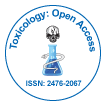Ecotoxicology: Understanding the Impact of Chemicals on Ecosystems
Received: 01-Jul-2024 / Manuscript No. tyoa-24-143037 / Editor assigned: 03-Jul-2024 / PreQC No. tyoa-24-143037 (PQ) / Reviewed: 17-Jul-2024 / QC No. tyoa-24-143037 / Revised: 19-Jul-2024 / Manuscript No. tyoa-24-143037 (R) / Published Date: 26-Jul-2024
Abstract
Ecotoxicology is the scientific study of the effects of toxic substances on ecosystems, encompassing both environmental and biological aspects. This field examines how pollutants and other harmful agents affect organisms at various levels of biological organization, from individual cells to entire ecosystems. By understanding these impacts, ecotoxicology aims to protect environmental health, maintain biodiversity, and ensure sustainable use of natural resources.
Keywords
Ecotoxicology; Pollutants; Toxins
Introduction
Ecotoxicology bridges the gap between toxicology, which focuses on the effects of chemicals on individual organisms, and ecology, which studies interactions within ecosystems. The field evaluates how chemicals, including heavy metals, pesticides, industrial pollutants, and pharmaceuticals, influence environmental health. The routes through which chemicals enter the environment, such as air, water, and soil. The persistence, bioavailability, and accumulation of these substances in various environmental compartments are critical factors in their potential toxicity [1-3].
Methodology
Unlike targeted chemicals, such as pesticides meant to control specific pests, many substances affect a wide range of non-target species. These effects can be direct, such as poisoning or reproductive harm, or indirect, affecting food webs and ecosystem functions. Chemicals can alter ecosystem dynamics by affecting species diversity, population densities, and community interactions. For instance, the decline of key species due to pollution can disrupt food webs and lead to imbalances in ecosystem processes.
Key concepts in ecotoxicology
Several concepts are central to understanding and evaluating ecological impacts:
Bioaccumulation refers to the build-up of toxic substances in an organism over time, while biomagnification describes the increase in concentration of these substances as they move up the food chain. These processes can lead to high levels of toxins in apex predators, affecting their health and reproductive success.
Ecotoxicologists use various testing methods to assess the effects of chemicals on organisms and ecosystems. These tests can be conducted in the laboratory (in vitro), in controlled field settings, or through modeling approaches. Tests often include examining the effects on aquatic life, soil organisms, and plants. Ecotoxicology involves evaluating the potential risks associated with chemical exposure and developing strategies to mitigate these risks. This includes setting regulatory limits, implementing pollution control measures, and promoting environmentally friendly practices [4-6].
Applications of ecotoxicology
Ecotoxicology has several practical applications, including:
Regulatory frameworks: Ecotoxicological research informs regulatory standards and guidelines aimed at limiting chemical releases and protecting environmental health. Regulatory agencies use ecotoxicological data to set safe exposure levels and develop policies for managing hazardous substances.
Environmental monitoring: Continuous monitoring of pollutants and their effects on ecosystems is essential for early detection of environmental issues. Ecotoxicology provides tools and methods for assessing the health of ecosystems and identifying potential threats.
Conservation efforts: By understanding the impacts of pollutants on biodiversity, ecotoxicologists contribute to conservation strategies aimed at preserving endangered species and restoring damaged habitats.
Challenges and future directions
Despite its importance, ecotoxicology faces several challenges. These include the need for more comprehensive and standardized testing methods, the complexity of interactions within ecosystems, and the long-term effects of low-level, chronic exposure to pollutants. Future research in ecotoxicology will focus on integrating new technologies, such as omics and molecular biology, to better understand the mechanisms of toxicity and improve risk assessment practices [7-10].
Conclusion
Ecotoxicology plays a vital role in understanding how chemicals impact ecosystems and maintaining environmental health. By studying the effects of pollutants on various biological levels, this field helps inform regulatory practices, guide conservation efforts, and promote sustainable environmental management. Continued research and advancements in ecotoxicology are essential for addressing emerging environmental challenges and ensuring the protection of our planet’s ecosystems.
References
- Alessandro A (2003) The aquatic geochemistry of Arsenic in volca- nic groundwaters from southern Italy. Appl Geochem 18: 1283-1296.
- Allan HS (2000) Contamination of drinking water by Arsenic in Bangladesh: A public health emergency, Bull World Health Organ 78: 1093-1103
- Amit C (1999) A study of groundwater contamination by Arsenic in Calcutta due to industrial pollution. Environ Pollut 80: 57-65.
- APHA (1989) Standard methods for the examination of water and wastewater.
- Chakraborti D (1999) Arsenic groundwater contamination and suffering of people in Rajnandgaon district MP India. Curr Sci 77: 502-504.
- Chakraborti D (2003) Arsenic groundwater contamination in Middle Ganga Plains Bihar India. Environ Health Perspect 111: 1194- 1201.
- Dhar RK (1997) Groundwater arsenic calamity in Bangladesh. Curr Sci 73: 48-59.
- Franco F (2003) Geochemical controls on arsenic distribution in the Bacca Locci stream catchment affected by past mining, Italy. J Appl Geochem 18: 1373- 1386.
- Hopenhayn RC (1996) Bladder cancer mortality associated with Arsenic in groundwater in Argentina. J Epidemiol 7: 117-124.
- Ondra S (2004) The behavior of Arsenic and geochemical modeling of arsenic enrichment in aqueous environments. J Appl Geochem 19: 169-180.
Indexed at, Google Scholar, Crossref
Indexed at, Google Scholar, Crossref
Indexed at, Google Scholar, Crossref
Indexed at, Google Scholar, Crossref
Citation: Anvita S (2024) Ecotoxicology: Understanding the Impact of Chemicals on Ecosystems. Toxicol Open Access 10: 287.
Copyright: © 2024 Anvita S. This is an open-access article distributed under the terms of the Creative Commons Attribution License, which permits unrestricted use, distribution, and reproduction in any medium, provided the original author and source are credited.
Share This Article
Open Access Journals
Article Usage
- Total views: 391
- [From(publication date): 0-2024 - Apr 02, 2025]
- Breakdown by view type
- HTML page views: 213
- PDF downloads: 178
